Meet Japan’s first female bathhouse artist
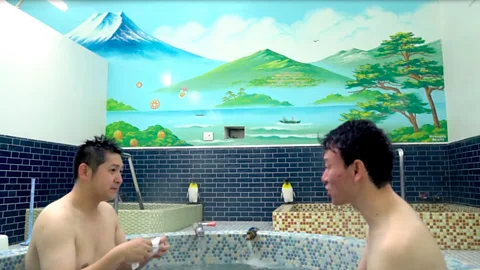 Mari Shibata
Mari ShibataAs the country’s ancient bathhouses disappear, a young artist is attempting to revitalise a 1,200-year-old tradition – one mural at a time.
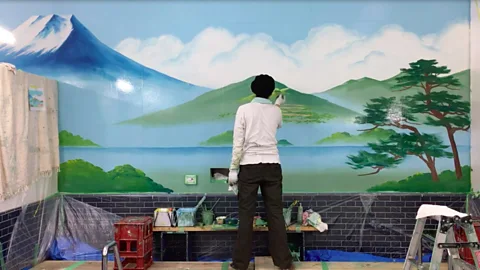 Eliot Stein
Eliot SteinIt’s a cold, grey morning in the sleepy Japanese port town of Yawatahama. Outside, driving rain splatters on the pavement and wind whips through the harbour. But inside the Taishoyu bathhouse, there are bright blue skies, sun-soaked islands and panoramic views of Mount Fuji – never mind that the snow-capped stratovolcano is 775km away. With a few more deft strokes from Mizuki Tanaka’s brush, pine trees, terraced orchards and bobbing sailboats appear, transforming a windowless wall into a soothing dreamscape designed to transport bathers into Zen-like oblivion.
For more than 1,200 years, public bathhouses, known as sento, have held an important cultural role in Japanese society. Traditionally, these temple-shaped structures were the only place where many Japanese families could bathe, and people walked there every day to soak under tranquil murals of idyllic landscapes. But in the last 50 years, the number of sento has plummeted from more than 18,000 to fewer than 3,000. And while there used to be dozens of sento mural painters, today only three specialists in Japan continue this ancient artform. One is 83 years old. Another is 73. At 36, Tanaka isn’t just the youngest: she’s Japan’s first and only female sento master, and she’s made it her mission to restore these beloved bathhouses to their former glory.
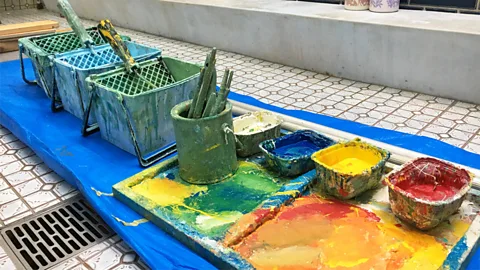 Eliot Stein
Eliot SteinFor the last six years, Tanaka has been driving up and down Japan in her old white truck, scraping off the peeling paint of faded bathhouse murals of yesteryear and refreshing the tiles in an effort to preserve this age-old art for future generations – and she doesn’t have much time.
Since most sento can’t afford to close more than once a week, Tanaka must start and finish each project in a single day. She arrives at each bathhouse early in the morning, lays wooden planks over the pools to form a walkway, mixes her colours and then climbs ladders or balances on upside-down crates to reach her floor-to-ceiling canvases. Many of Tanaka’s murals, like the one inside the Taishoyu sento, are massive scenes splashed across 8m walls. She estimates it will take her about 11 hours of work to complete this faraway fairy tale, but knows that for most bathers, stepping into a sento is an escape from the outside world, and her murals are an essential part of that experience.
“After a long day or when you’re feeling down, and there’s this really bright sky and landscape, you feel uplifted,” Tanaka said. “That’s why I do this.”
 Mari Shibata
Mari ShibataSento date to the spread of Buddhism across Japan during the 700s, when cleansing one’s body and spirit was thought to be an important duty for those serving Buddha. Originally only found in large temples, these communal steam baths eventually extended to the paying public, and during the 1200s, the term ‘sento’ (literally: ‘coin bath’) was introduced.
According to the Tokyo Sento Association, by the early 1600s, each Tokyo neighbourhood had its own bathhouse, and many were adorned with nature scenes on the walls. By 1810, records show there were 523 sento in the city, yet it wasn’t until the Meiji period starting in 1868 that the modern sento took shape: separate men’s and women’s entrances and naked bathing areas, recessed tubs, high ceilings and paintings often depicting Japan’s most enduring and powerful landmark: Mount Fuji.
Japan’s rapid post-World War Two construction boom cemented sento’s cultural and social importance. As many homes throughout Japan lacked private baths of their own, public bathhouses not only served a necessary hygienic function, but became a popular daily meeting place for friends and neighbours to socialise, learn news and unwind. At the peak of their popularity in 1968, there were 18,325 sento spread across the country.
 Mari Shibata
Mari ShibataSento are a place of sharing – maybe the only place where you forget about social rank. There is a phrase, ‘hadaka no tsukiai’ (‘naked friendship’). Everybody is naked, everybody is the same,” said Stéphanie Crohin, Japan’s first sento ambassador and an author of a book on the subject.
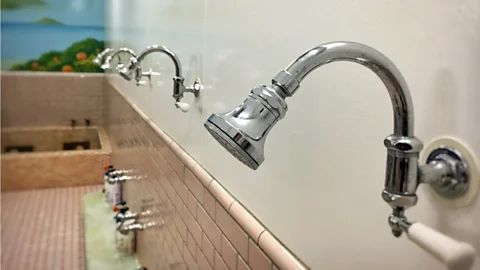 Eliot Stein
Eliot SteinAs Japan’s economy grew in the 1970s and increasing numbers of people had access to private baths, sento around the country began to shut. This trickle has since turned into a torrent, and today, as few as 2,600 remain. In fact, of the nine bathhouses that once operated in Yawatahama, Taishoyu is the last one standing.
“In the past, about 130 people came here each day. Now, there are maybe 30,” said Taishoyu’s 79-year-old owner, Minoru Yamauchi, whose family has run the sento for three generations. “If sento disappear, you lose that connection between people and the community.”
While Taishoyu hasn’t changed much since Yamauchi’s grandfather opened it in 1915, its layout is typical of many sento throughout Japan. After paying 380-500 yen (£2.65-£3.50) to enter, guests leave their shoes at the door, push past a curtain and enter separate men’s and women’s changing areas. Unlike Japanese onsen, which are fed by volcanic hot springs and often set in a spa-like setting, sento are generally no-frills affairs. Bathers wash off in a shower and sink into a steaming tub heated by gas – or in rare instances, like at Taishoyu, a wood-burning stove – before letting their cares melt away as they gaze up at scenes that are as soothing to the mind as hot water is to the body.
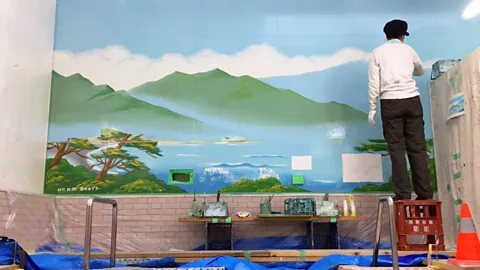 Eliot Stein
Eliot SteinIronically, Tanaka didn’t set out to be sento art’s trailblazer or its cultural custodian. Growing up in Tokyo at a time when most families had their own baths, she never visited a sento as a child. It was only when she studied art history at university that she first discovered bathhouse murals. “As I furthered my research, I noticed a style that’s very distinct,” she said. “I found that fascinating.”
Then in 2004, Tanaka learned that one of Japan’s two remaining sento masters, Morio Nakajima, was hosting a painting demonstration in Tokyo. Tanaka attended and asked Nakajima after the show if he’d be willing to teach her, unaware that there had never been a female painter before.
When Tanaka first approached Nakajima, however, he declined to teach her. “I was told there weren’t any jobs, let alone [opportunities] for students to come on board,” she said. Tanaka told Nakajima that she wasn’t interested in making a living, she just wanted to learn the techniques. He eventually agreed, on one condition: “That I also have another job, because he might not be able to afford to feed me,” she ed. It would be the beginning of an eight-year apprenticeship.
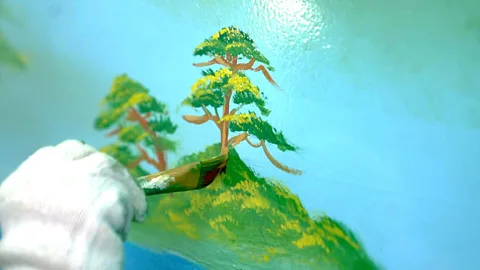 Mari Shibata
Mari ShibataMy mother didn't raise me to be aware of my gender as a woman. She would just tell me, ‘if there is something you want to do, try it’,” Tanaka said.
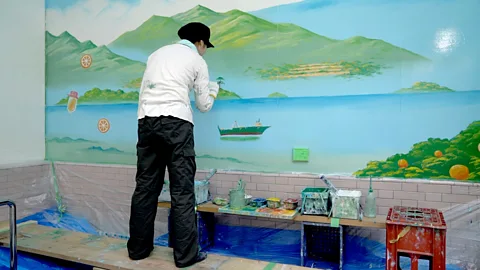 Mari Shibata
Mari ShibataWhen she wasn’t unloading supplies or hauling heavy cans of paint up and down ladders, most of Tanaka’s first year with Nakajima was spent quietly observing him work. Over time, Nakajima allowed her to begin drawing small sections of his paintings, teaching her from the top of the mural down – rolling the blue sky, adding shadows to the puffy clouds, painting the smaller pine trees and mixing colours to show movement in the sea. But for more than six years, one thing she was never allowed to do was paint Mount Fuji.
As part of Tanaka’s sento study, Nakajima taught her about the industry’s golden era. When he entered the trade in 1964, his four-artist company was one of 16 bathhouse mural businesses in Tokyo. Throughout the 1960s and ‘70s, he would paint between 600 and 800 sento murals a year, but in the years before taking on Tanaka, he’d be lucky to paint 100. And as Tanaka soon realised, because of the job’s physical demands and toxic chemicals that could affect women hoping to have children, there had never been a female master.
“Beyond the male-dominated field, this is a dying art,” Crohin said. “Only three people are able to realise [sento murals] now. She is perpetuating this majestic art, and she is very courageous.”
 Eliot Stein
Eliot SteinThese days, Tanaka paints about 20 sento a year, and since new bathhouses aren’t being built, most of her work is painting over older murals. Traditionally, these frescoes were revitalised every few years, but as sento customers and artists have disappeared, many bathhouses – like Taishoyu – now wait more than a decade to refresh them.
The inspiration for each new scene starts with a sketch. After hearing the elements an owner has in mind, Tanaka will send over several two-sheet options – one side showing the men’s bath, the other showing the women’s. While rolling foothills and cerulean seas are common, no two landscapes are identical because owners typically like to incorporate subtle local elements to remind bathers of home. For Tanaka, that may mean adding Shinto shrines in Tokyo, bamboo groves in Kyoto or, in the case of Yawatahama, oranges and tangerines to get residents excited about the town’s inaugural marmalade festival this May.
There are also rules around what should (and shouldn’t) be painted. Since bathers soak year-round, sento art generally shouldn’t show seasonal elements. Light blues and pastels are considered the most uplifting, and mountains and waterfalls may bring good luck. But falling leaves, sunsets or the colour red are considered bad omens.
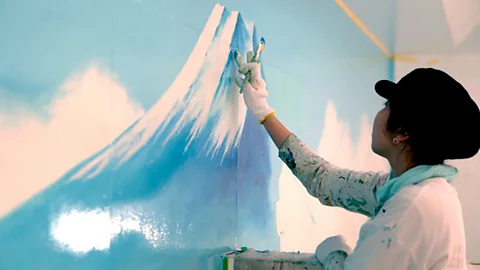 Mari Shibata
Mari ShibataWhen it comes to sento superstition, no image is considered more auspicious than Japan’s best-known and most revered landmark: Mount Fuji. A sacred place for many Japanese and a source of artistic inspiration for a millennium, the 3,776m mountain is believed to have first appeared on sento walls in 1912. Ever since, its snow-dusted crest has risen above the steam in bathhouses throughout Japan, and made weary bathers feel as if they’re purifying themselves in its waters.
“Ninety percent of my paintings include Mount Fuji,” Tanaka said. “It’s part of [Japanese] people’s psyche.” Despite the fact that Tanaka has immortalised the mountain hundreds of times, it remains among the most difficult elements for her to paint. Since there are nearly as many views of Fuji as there are murals of it, Tanaka is often asked by sento owners to portray the peak from the direction it would be seen from the bathhouse. So, when she’s not painting the mountain, Tanaka spends time studying images and collecting pamphlets showing it from different angles across Japan.
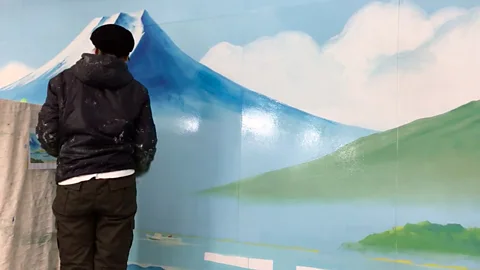 Eliot Stein
Eliot SteinMount Fuji touches Japanese people’s souls. It makes me feel calm and peaceful,” Yamauchi said.
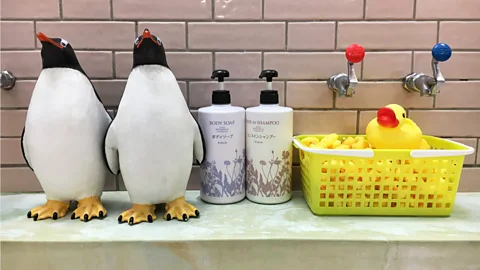 Eliot Stein
Eliot SteinTanaka isn’t sure when the other two masters may hang up their brushes, but she does know that she alone cannot ensure sento’s survival. In recent years, she’s begun hosting live painting demonstrations, giving TED Talks and leading instructional workshops in hopes of spreading this ancient art to future generations. So far, her efforts seem to be working.
Long viewed as a reminder of Japan’s impoverished past, today these retro-chic spas are experiencing a slow resurgence among younger Japanese. Second- and third-generation owners are turning to social media to breathe new life into their bathhouses, the Tokyo Sento Association has appointed two ambassadors to spread sento culture to foreigners, and some bathhouses have even begun offering classes and events to lure younger bathers.
“There are lots of people who haven't been to sento before, so it's about getting them interested to begin with,” Tanaka said. “I recently learned that when I’ve done workshops with children, they started going to the sento after participating, even though they had never been to one until then. It’s a small step, but I do think it’s gradually leading towards something.”
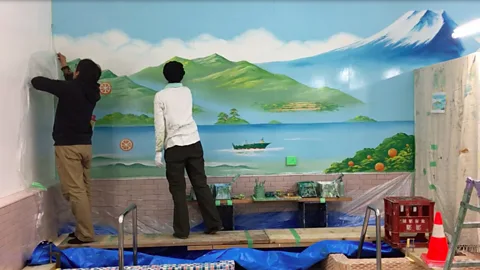 Eliot Stein
Eliot SteinWhile attending one of these events a few years ago, Tanaka met handyman Komamura Yoshikazu. She was there to discuss sento culture, and he had built the stage. The two soon fell in love, married, and today she and Yoshikazu travel up and down Japan as part of a sento painting partnership: she does the painting, and he builds the wooden stages and metal scaffolding where she works.
“I drive, I carry heavy things and I try to her,” Yoshikazu smiled.
As Tanaka sweeps her brush across the painted valleys on the women’s side of the Taishoyu bathhouse, Yoshikazu has already laid a planked walkway over the pools on the men’s side and readied her paint on a makeshift stand. There’s no time to waste: It’s 13:30, half of the mural still remains to be done and the sento is scheduled to open the next day.
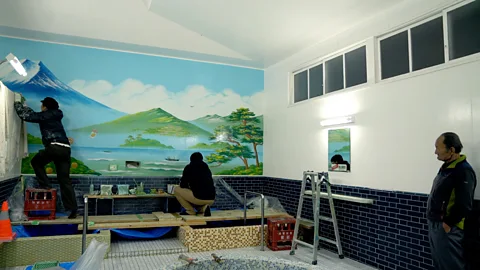 Mari Shibata
Mari ShibataEleven hours after she started painting, Tanaka stretches atop an upside-down carton to apply the final flourishes to Mount Fuji’s snow-white summit. As Yoshikazu dissembles the planked walkway and removes the protective tarp, Yamauchi gazes up at his sento’s new towering centrepiece and smiles. Without taking his eyes off Fuji’s peak, he calls his daughter and son-in-law in from the lobby to come see it for themselves.
Before Tanaka leaves, Yamauchi and his family ask if they can take her picture to frame on the sento wall, to which she graciously agrees. Three journalists from the local newspaper and the deputy mayor had come to meet her earlier in the day, too. After bowing to the owner in thanks, Tanaka and Yoshikazu head back into the rain and towards their old white truck, but not before Yamauchi tells them to come back soon. After all, there’s a marmalade festival in May.
(Text by Eliot Stein; video by Mari Shibata)
Custom Made is a BBC Travel series that introduces you to custodians of cultural traditions all around the world.
